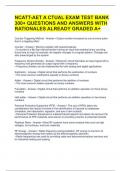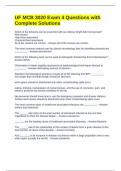NCATT-AET A CTUAL EXAM TEST BANK
300+ QUESTIONS AND ANSWERS WITH
RATIONALES ALREADY GRADED A+
Counter Triggering Method - Answer-• Output number increases by one at every pulse
due to a toggling effect
Counter - Answer-• Memory register with special features
• A counter is a flip-flop interconnection having an input that enables binary counting.
Every time an input is received, the register changes in a regular pattern. Changes are
also prearranged by the system
Frequency Division/Divider - Answer-• Electronic circuit that takes an input signal with a
frequency and generates an output signal with a frequency
• Frequency dividers can be implemented for both analog and digital applications
Subtractor - Answer-• Digital circuit that performs the subtraction of numbers
• The most common subtractors operate on binary numbers
Adder - Answer-• Digital circuit that performs the addition of numbers
• The most common adders operate on binary numbers
Full-adder - Answer-• Digital circuit that performs an addition operation on three binary
numbers
Half-adder - Answer-• Digital circuit that performs an addition operation on two binary
numbers
Personal Protective Equipment (PPE) - Answer-• The use of PPEs takes into
consideration key factors involved in the identification of hazards to employees
(inhalation, skin absorption, ingestion, and eye or skin contact)
• Personal Protection Equipment is material-hazard specific and takes into account the
performance of PPE materials (and seams) in providing a barrier to potential hazards
Residual Risks - Answer-• Most RF systems have some residual risks such as high
voltages, hot surfaces, and toxic materials
RF Energy - Answer-• Radio frequency energy/radiation. RF energy is one form of
electromagnetic energy that makes up the electromagnetic spectrum
• Radio frequencies are used for providing radar and telecommunications services and
for industrial heating and sealing
,RF Protection Program - Answer-• Includes training in normal operation of equipment,
support such as periodic screening of employees and facilities, and applicable
emergency procedures
Specific Absorption Rate (SAR) - Answer-• Common measure of exposure to RF energy
Active Hearing Protection - Answer-• Active Noise Reduction (ANR) earmuffs, headsets,
and helmets containing electronic components that enhance communications
• These devices substantially improve intelligibility and comfort, which decreases fatigue
Allowable Daily Exposure - Answer-• OSHA has adopted a 90 dB (A) level limit within a
daily 8- hour exposure
Noise Protection Program - Answer-• Includes training in normal operation of
equipment, support such as periodic screening of employees and facilities, and
applicable emergency procedures
Noise - Answer-• Refers to a sound, especially one that is noticeably unpleasant and
very loud
Passive Hearing Protection - Answer-• Earplugs and earmuffs with low-level protection
Job Briefings - Answer-• Meetings with employees involved before they start each job
• A Job briefing covers the following subjects: Hazards associated with the job Work
procedures involved Special precautions Energy source controls PPE requirements
Electrical Protective Devices - Answer-• Protective electrical insulated gloves and
sleeves or other electrical protective equipment to be worn when employees are
exposed to electrical shock hazards while working on electrical equipment
Circuit Protection Devices - Answer-• Include fuses, current limiters, thermal protectors
(switches), and circuit breakers
Elimination/Termination of Circuit Power - Answer-• Specific procedural steps for
shutting down, isolating, blocking, and securing machines or equipment to control
hazardous energy sources
• Lockout/tagout devices are often used
• There are also procedures for the placement, removal, and transfer of these devices
Electrical Power Protection Program - Answer-• Includes training in normal operation of
equipment, job briefings, support of safety-related work practices, and applicable
emergency procedures
ESD - Answer-• Electrostatic Discharge is the instantaneous discharge of static
electricity that has built up on one surface or point and is discharged to another surface
or point
,ESD Control Program - Answer-• Grounded workstation surfaces and equipment
• Personnel grounding
• Handling precautions
• Protective packaging for ESD items when transporting or storage
Conductive Wrist Strap (Connected to Earth Ground) - Answer-• Worn by an individual
to keep a workstation free of static charges
MIL-STD-129 - Answer-• ESD caution standard (military) that includes procedures for
precautionary measures
ESD Protection Program - Answer-• Includes training in examples of ESD failures,
prevention, support of safety-related work practices, and applicable emergency
procedures
Microwave (MW) Energy / Radiation - Answer-• Microwave energy is one form of
electromagnetic energy that makes up the electromagnetic spectrum
• Microwave frequencies are normally used for satellite communication and radar
• These frequencies are also used for bonding composite sheets for the automotive and
aerospace industries
Microwave Protection Program - Answer-• Includes training in normal operation of
equipment, support such as periodic screening of employees and facilities, and
appropriate emergency procedures
Acetone - Answer-• Organic solvent of industrial and chemical significance
• Acetone is colorless, volatile, and extremely flammable
Adhesives - Answer-• Substances that adhere or bond two components, or items,
together
• Many adhesives contain flammable and toxic elements
Caustic Solutions - Answer-• Substances that can burn and destroy living tissues or soft
metals
• Caustic solutions are usually strong acids and/or bases
Cleaners - Answer-• Substances that may contain solvents, corrosives, or any number
of chemicals to clean an aircraft
Coatings - Answer-• Substances that function to protect surfaces
• Coatings contain pigments, paints, solvents, drying oils, and other additives
Degreasers and Strippers - Answer-• Substances that clean commercial and industrial
parts • Many degreasers and strippers contain flammable and toxic elements
, Hazardous Liquids - Answer-• Includes corrosives, ignitables, and reactives, as well as
chemicals used as solvents, cleaners, caustic solutions, degreasers, strippers,
adhesives, and coatings
Solvents - Answer-• Substance that dissolves another substance or substances to form
a solution
• Solvents are usually, but not always liquid
• Solvents can also be gases or solids
Methyl Ethyl Ketone (MEK) - Answer-• Solvent used in the surface coating industry and
in dewaxing of lubricating oils
• Methyl Ethyl Ketone may be used with other solvents such as acetone, ethyl acetate,
hexane, toluene, and alcohols
Explain first aid for electrical shock with reference to the following safety precautions: -
Answer-• TURN OFF THE POWER as quickly as possible • If unable to locate the
power switches, do not attempt to touch the victim. Touching the victim will pass the
current through anyone who touches the victim
• If electrical power cannot be removed, use a dry wooden pole, wooden broom, or dry
wooden chair to PUSH or ROLL the victim clear of the power source. Dry,
nonconducting objects made of cardboard, plastic, or wood are suitable to use to
remove the victim from the power source
• If clothing, belt, rope, or cord must be used, be careful to AVOID CONTACT WITH
THE VICTIM! Form the rescue device into a loop, and slip the loop over the foot, leg, or
arm of the victim (without touching the victim) to drag them away from the power source
• Once the victim is "free" of the power source, do not move them unless it is necessary
• Proper Steps to Take in Case of Need for First Aid—When someone needs first aid
after electrical shock, follow these steps: > Keep the victim lying down > Slightly elevate
their legs and feet > Cover the victim with a blanket to maintain body heat > Do not
move the victim unless it is necessary > Seek qualified medical aid, but try not to leave
the victim alone > If the victim needs water, give them a few sips of water at first. Then,
gradually increase water intake unless nausea is present
First Aid and CPR: - Answer-American Heart Association Guide for CPR, October 18,
2010:
• Call 911 or ask someone else to do so
• Try to get the person to respond; if he doesn't, roll the person on his or her back
• Start chest compressions. Place the heel of your hand on the center of the victim's
chest. Put your other hand on top of the first with your fingers interlaced
• Press down so you compress the chest at least 2 inches in adults and children and 1.5
inches in infants. ''One hundred times a minute or even a little faster is optimal," (That's
about the same rhythm as the beat of the Bee Gee's song "Stayin' Alive.")
• If you're been trained in CPR, you can now open the airway with a head tilt and chin lift
• Pinch closed the nose of the victim. Take a normal breath, cover the victim's mouth
with yours to create an airtight seal, and then give two, one-second breaths as you
watch for the chest to rise






